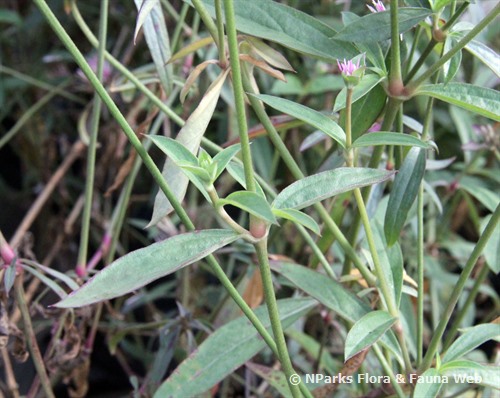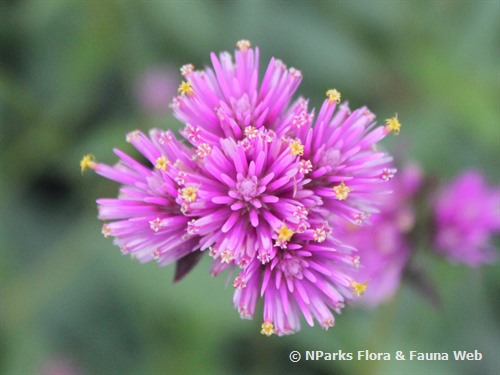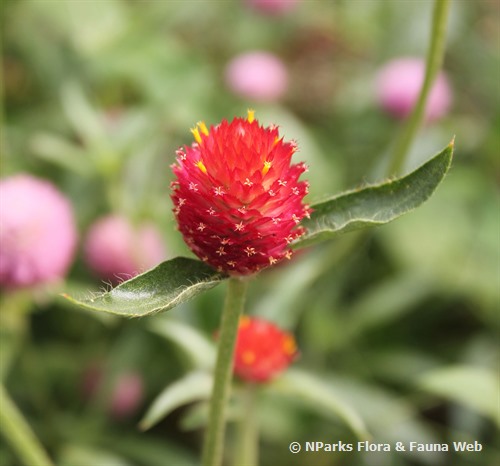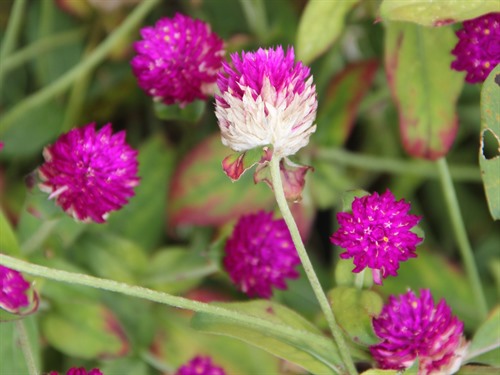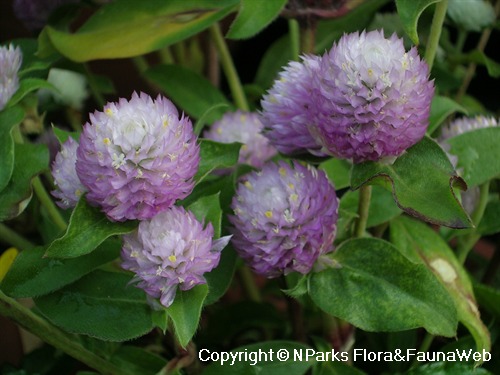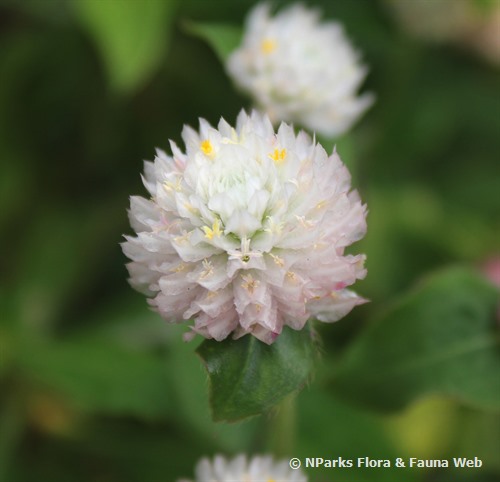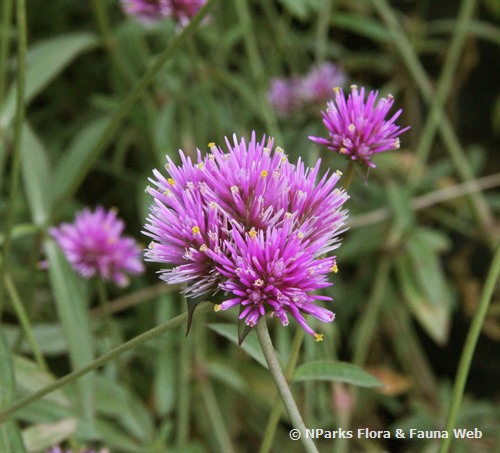
Back
Gomphrena globosa 'Fireworks'
| Family Name: | Amaranthaceae |
| Common Name: | Globe Amaranth 'Fireworks', Bachelor's Button 'Fireworks', 千日红 |
Name
Classifications and Characteristics
| Plant Division | Angiosperms (Flowering Seed Plants) |
|---|---|
| Plant Growth Form | Herbaceous Plant |
| Lifespan (in Singapore) | Perennial |
| Mode of Nutrition | Autotrophic |
| Maximum Height | 0.9 m to 1.2 m |
| Maximum Plant Spread / Crown Width | 0.9 m to 1.2 m |
Biogeography
| Native Distribution | Of horticultural origin |
|---|
Description and Ethnobotany
| Growth Form | Although often considered an annual, it is a perennial herb in frost-free climates and grows up to 0.9-1.2 m tall. |
|---|---|
| Foliage | Its leaves are opposite, oblong to elliptic. |
| Flowers | The true flowers are yellow, narrow and tubular. They are interspersed among the pink to light purple petal-like structures known as bracts. The inflorescence is technically known as a dichasial cyme in a head of bracts which is about 2.5 cm wide. This cultivar has a long blooming season and the flowers are long-lasting. |
| Fruit | The small, balloon-like fruit is known as a utricle, and it contains one round, yellow-brown seed. |
| Cultivation | This easy-to-grow, fast-growing cultivar tolerates drought and heat well when established. It grows best in well-drained soils, but can also grow in clay soils. Avoid over-watering. You don't need to remove spent flowers, but it might self-seed and form new seedlings. |
| Etymology | The cultivar name 'Fireworks' refers to the starburst shape of the inflorescence which is different from the more typical, conical shape of other cultivars. |
| Ethnobotanical Uses | Cut - Dried Flower: The flowers are ideal for flower arrangement because of the long-lasting and bright-colored flowers. They should be harvested before the bloom is fully open. |
Landscaping Features
| Desirable Plant Features | Ornamental Flowers |
|---|---|
| Landscape Uses | Parks & Gardens, Small Gardens, Flowerbed / Border |
| Thematic Landscaping | Naturalistic Garden |
Fauna, Pollination and Dispersal
| Fauna Pollination Dispersal Associated Fauna | Butterfly-Attracting |
|---|
Plant Care and Propagation
| Light Preference | Full Sun |
|---|---|
| Water Preference | Moderate Water |
| Rootzone Tolerance | Well-Drained Soils, Easy to Grow |
| Propagation Method | Seed |
Foliar
| Foliage Retention | Evergreen |
|---|---|
| Mature Foliage Colour(s) | Green |
| Mature Foliage Texture(s) | Smooth |
| Foliar Type | Simple / Unifoliate |
| Foliar Arrangement Along Stem | Opposite |
| Foliar Attachment to Stem | Petiolate |
| Foliar Shape(s) | Non-Palm Foliage |
| Foliar Venation | Pinnate / Net |
| Foliar Margin | Ciliate / Hairy |
| Foliar Apex - Tip | Acute |
| Foliar Base | Rounded / Obtuse |
Floral (Angiosperm)
| Flower & Plant Sexuality | Bisexual Flowers |
| Flower Colour(s) | Pink, Purple |
|---|---|
| Flower Grouping | Cluster / Inflorescence |
| Flower Location | Terminal |
| Flower Symmetry | Radial |
| Individual Flower Shape | Tubular |
| Inflorescence Type | Cyme |
Fruit, Seed and Spore
| Mature Fruit Colour(s) | Brown |
|---|---|
| Mature Fruit Texture(s) | Papery |
| Fruit Classification | Simple Fruit |
| Fruit Type | |
| Mature Seed Colour(s) | Brown |
| Mature Seed Texture(s) | Smooth |
Image Repository
Others
| Master ID | 32942 |
|---|---|
| Species ID | 7356 |
| Flora Disclaimer | The information in this website has been compiled from reliable sources, such as reference works on medicinal plants. It is not a substitute for medical advice or treatment and NParks does not purport to provide any medical advice. Readers should always consult his/her physician before using or consuming a plant for medicinal purposes. |


